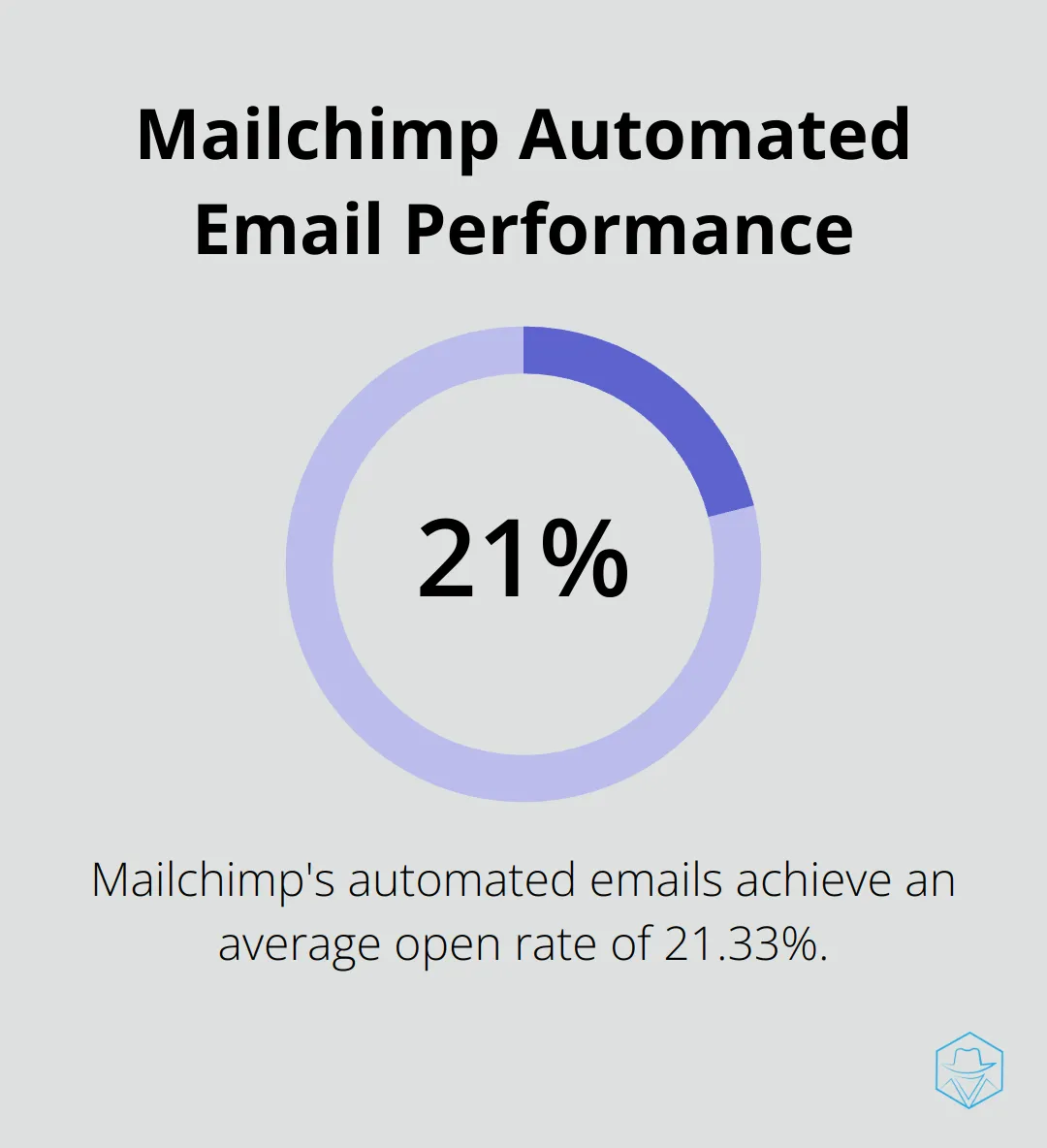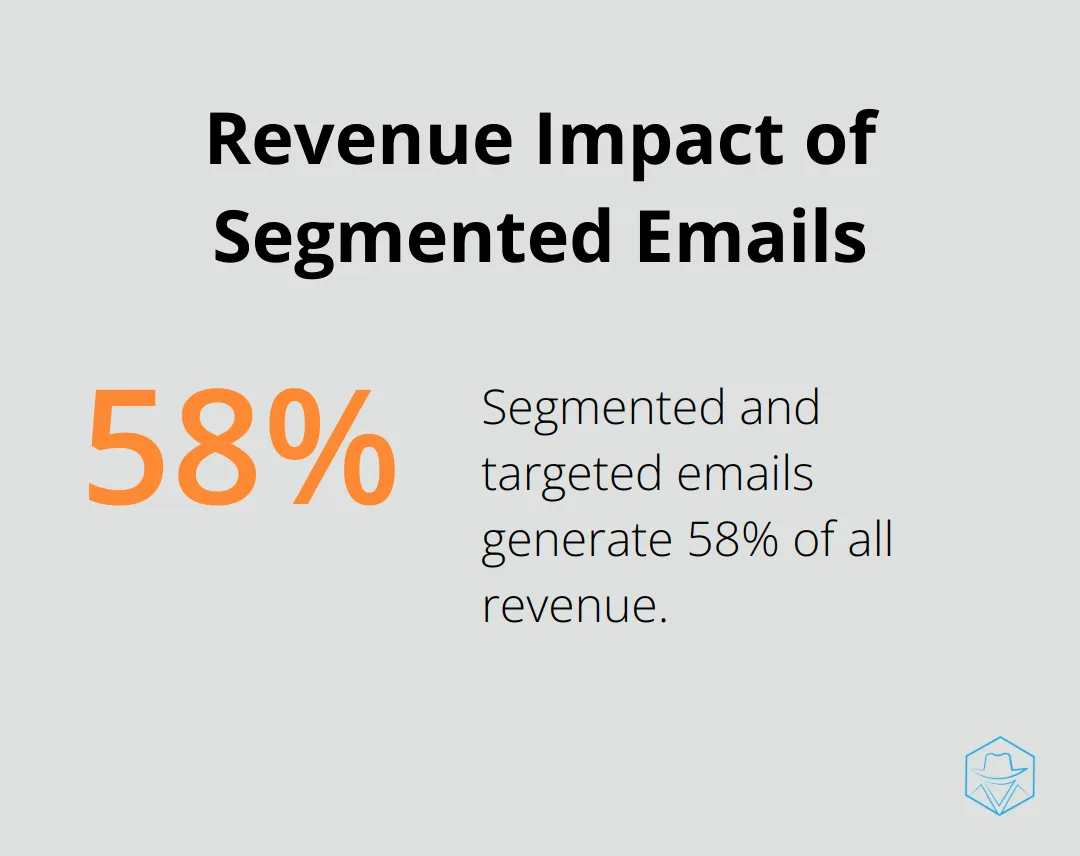Klaviyo vs Mailchimp: Which Email Platform to Choose?

At Drop Cowboy, we understand the importance of choosing the right email marketing platform for your business.
Klaviyo vs Mailchimp is a common comparison many marketers face when selecting their email tool. Both platforms offer unique features and pricing structures that cater to different business needs.
In this post, we’ll break down the key differences between Klaviyo and Mailchimp to help you make an informed decision for your email marketing strategy.
How Do Klaviyo and Mailchimp Compare?
Klaviyo and Mailchimp offer distinct features that cater to different business needs. We at Drop Cowboy understand the importance of choosing the right email marketing platform. Let’s explore how these two giants stack up against each other in key areas.
Email Campaign Creation and Management
Mailchimp provides a user-friendly interface with drag-and-drop editors and pre-designed templates, which makes it easier for beginners to create visually appealing emails. Klaviyo’s email editor offers more flexibility for advanced users who want to customize their designs, but it has a steeper learning curve.
Klaviyo excels in creating highly personalized emails based on customer data and behavior. This level of personalization can lead to higher engagement rates (a study by Experian found that personalized emails deliver 6x higher transaction rates).

Automation Capabilities
Klaviyo stands out with its advanced automation workflows. Users can set up complex, multi-step marketing initiatives based on customer behavior. The platform allows triggers for abandoned carts, post-purchase follow-ups, and even predicts future customer behavior.
Mailchimp offers more basic automation options. Their “Customer Journey Builder” simplifies the process of creating automated campaigns, but it lacks the depth and flexibility of Klaviyo’s offerings.
E-commerce Integration
For e-commerce businesses, Klaviyo takes the lead. It integrates seamlessly with major e-commerce platforms like Shopify and WooCommerce. This integration enables real-time data syncing, allowing users to create highly targeted campaigns based on purchase history and browsing behavior.
Mailchimp’s e-commerce integrations, while available, are not as robust. They’ve experienced issues with certain platforms in the past, which might concern e-commerce-focused businesses.
Segmentation and Personalization
Klaviyo’s segmentation capabilities are unmatched. Users can create highly specific segments based on a wide range of customer data points. This granular segmentation allows for hyper-personalized messaging, which can significantly boost engagement and conversion rates.
Mailchimp offers segmentation options, but they’re more limited compared to Klaviyo. While users can create basic segments, they might find it challenging to achieve the same level of targeting as with Klaviyo.
Analytics and Reporting
Both platforms offer analytics and reporting features, but Klaviyo goes a step further with its predictive analytics. These tools help users anticipate customer behavior and optimize marketing strategies accordingly.
Mailchimp’s reporting is more straightforward and easier to understand for beginners. However, it lacks the depth and predictive capabilities that Klaviyo offers. Despite this, Mailchimp’s automated emails have been reported to achieve an average open rate of 21.33%, which is significant in the industry.

As we move forward to discuss pricing and plans, it’s important to consider how these features align with your business needs and budget. The next section will break down the cost structures of both platforms to help you make an informed decision.
How Much Do Klaviyo and Mailchimp Cost?
Klaviyo’s Pricing Model
Klaviyo bases its pricing on the number of contacts in your database. The platform starts at $20 per month for up to 500 contacts and increases from there. For 10,000 contacts, the cost reaches approximately $150 per month. Klaviyo offers a free plan for up to 250 contacts and 500 email sends (perfect for small businesses to test the platform).
A standout feature of Klaviyo’s pricing is the inclusion of all tools in every plan. This means access to advanced segmentation, automation, and predictive analytics without extra charges. Growing businesses can leverage sophisticated marketing strategies without incurring additional costs.
Mailchimp’s Tiered Approach
Mailchimp uses a tiered pricing structure with four main plans: Free, Essentials, Standard, and Premium. The Free plan accommodates up to 2,000 contacts and 10,000 sends per month (an attractive option for startups and small businesses).
The Essentials plan begins at $11 per month for up to 500 contacts, while the Standard plan starts at $17 per month. The Premium plan, which includes advanced features like multivariate testing and comparative reporting, starts at $299 per month for up to 10,000 contacts.
Mailchimp’s pricing can increase rapidly as your contact list grows. For example, the Standard plan jumps to $74.99 per month for 5,000 contacts.
Cost-Effectiveness for Different Business Sizes
Small businesses and startups with limited budgets might find Mailchimp’s free plan a good starting point. However, as marketing needs become more complex, Klaviyo’s all-inclusive pricing model may provide better value.
Mid-sized businesses often find Klaviyo more cost-effective in the long run. While the initial price point may be higher, the advanced features included in all plans can lead to more effective campaigns and potentially higher ROI.
Large enterprises with extensive contact lists might see significant cost savings with Klaviyo. For instance, a business with 100,000 contacts would pay around $1,000 per month with Klaviyo, whereas Mailchimp’s Premium plan for the same number of contacts would cost approximately $1,300.
Return on Investment Considerations
The upfront costs tell only part of the story. The potential return on investment plays a significant role in the decision-making process. Klaviyo’s advanced segmentation and personalization features have shown to drive higher engagement rates, which could translate to increased revenue. A study by DMA found that segmented and targeted emails generate 58% of all revenue.

Pricing Flexibility and Scalability
Both platforms offer flexibility in their pricing structures, allowing businesses to scale their email marketing efforts as they grow. Klaviyo’s pricing scales linearly with the number of contacts, while Mailchimp’s tiered approach might result in more significant jumps in cost as you move between tiers.
The choice between Klaviyo and Mailchimp often comes down to more than just price. The features, ease of use, and overall user experience play a significant role in determining which platform provides the best value for your business. In the next section, we’ll explore these aspects to give you a comprehensive understanding of what each platform offers beyond their pricing structures.
How User-Friendly Are Klaviyo and Mailchimp?
Interface and Navigation
Mailchimp’s interface stands out for its simplicity. The dashboard presents a clean, intuitive layout that new users quickly grasp. Key features are easily accessible, with a logical flow from campaign creation to sending. This design philosophy has contributed to Mailchimp’s popularity, especially among small businesses and startups.
Klaviyo’s interface packs more power but adds complexity. It handles sophisticated e-commerce marketing strategies, which means more options and features appear on the dashboard. For users familiar with advanced email marketing techniques, this depth can be a significant advantage. However, beginners might find it overwhelming.
Learning Curve and Onboarding
Mailchimp offers a gentler learning curve. New users can create and send their first campaign within minutes, thanks to the platform’s straightforward design and helpful tooltips. Mailchimp’s onboarding process includes a series of guided tours and tutorials, making it easier for newcomers to start.
Klaviyo’s learning curve is steeper, reflecting its more advanced capabilities. The platform requires users to invest more time in understanding its features to fully leverage its power. However, Klaviyo provides comprehensive onboarding resources, including video tutorials, webinars, and a knowledge base. These resources can significantly shorten the learning period for motivated users.
Customer Support and Resources
Both platforms offer extensive customer support, but with different approaches. Mailchimp provides 24/7 email support for all paid plans, with chat support available for higher-tier plans. Their knowledge base covers most common issues users might encounter.
Klaviyo takes customer support a step further. They offer email and chat support even for their free plan users (which is uncommon in the industry). For paid plans, Klaviyo provides dedicated onboarding specialists to help new users set up their accounts effectively. This personalized approach can be particularly valuable for businesses transitioning from other platforms or setting up complex automation workflows.
In terms of educational resources, both platforms excel. Mailchimp’s Marketing Library offers a wealth of guides, tutorials, and case studies. Klaviyo’s Academy provides in-depth courses on email marketing strategies, helping users not just with the platform itself, but with broader marketing concepts.
Platform Comparison
The choice between Klaviyo and Mailchimp in terms of user experience depends on your business needs and technical expertise. Mailchimp might be the go-to for those who prioritize ease of use, while Klaviyo could be the better choice for businesses ready to explore advanced e-commerce email marketing strategies.
However, it’s important to note that while Mailchimp and Klaviyo are strong contenders, Drop Cowboy offers a unique blend of user-friendliness and advanced features. Our platform combines an intuitive interface with powerful tools, providing a seamless user experience without sacrificing functionality.
Email automation capabilities are a key factor to consider when choosing between these platforms. Users report an average open rate of 21.33% for automated emails with Mailchimp, which is significantly higher than industry standards.
Final Thoughts
Klaviyo vs Mailchimp presents a clear choice for businesses with different needs. Klaviyo excels in e-commerce capabilities, deep segmentation, and powerful automation features, making it ideal for data-driven marketing strategies. Mailchimp offers a user-friendly interface, extensive template library, and affordable entry-level plans, appealing to small businesses and startups.
The decision between these platforms depends on your specific business requirements, technical expertise, and growth projections. Consider your budget, marketing strategy complexity, and long-term goals when making your choice. Both platforms have strengths, but they cater to different types of users and business models.
At Drop Cowboy, we provide a unique solution that combines marketing automation with ringless voicemail and SMS capabilities. Our platform offers additional channels to reach your audience, potentially increasing engagement rates beyond traditional email marketing. You can explore our innovative approach to marketing automation on our website.
blog-dropcowboy-com
Related posts

April 17, 2025
Revolutionize Your Agency with Marketing Automation
Transform your business with marketing agency automation. Explore practical tips and boost efficiency to drive growth in your agency today.

March 20, 2025
Zoho Marketing Automation: Features and Advantages
Explore Zoho Marketing Automation features and benefits to streamline your campaigns and boost engagement effectively.

March 19, 2025
How to Choose the Best CRM for Marketing Automation
Find the right CRM for marketing automation and boost your business efficiency with these practical tips and tools. Learn how to make an informed choice.

February 26, 2025
Choosing the Right Ringless Voicemail Service Provider
Explore tips for choosing the right ringless voicemail service and make informed decisions with ease. Learn key factors and avoid common pitfalls today!

April 14, 2025
How to Integrate Triple Whale with Your Shopify Store
Integrate Triple Whale with Shopify to boost sales. Follow our step-by-step guide for seamless setup and enhance your e-commerce store’s performance today.

February 28, 2025
How to Create a Winning Text Messaging Marketing Campaign
Boost engagement with expert tips on creating a winning text messaging campaign marketing strategy that drives results and increases customer interaction.